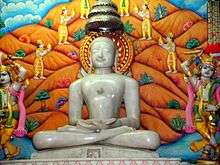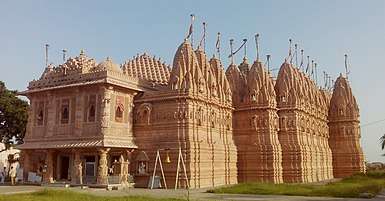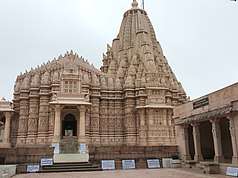Ajitanatha
Ajitnath (lit. invincible) was the second tirthankara of the present age, avasarpini (half time cycle) according to Jainism. He was born to King Jitashatru and Queen Vijaya at Ayodhya in the Ikshvaku dynasty. According to Jain legends, he became a siddha, a liberated soul which has destroyed all of its karma.
| Ajitanatha | |
|---|---|
2nd Jain Tirthankara | |
 Lord Ajitanatha (Mathura Chaurasi) | |
| Venerated in | Jainism |
| Predecessor | Rishabhanatha |
| Successor | Sambhavanatha |
| Symbol | Elephant |
| Height | 450 bows (1,350 meters) |
| Age | 72 lakh purva (508.032 x 1018 years old) |
| Color | Golden |
| Personal information | |
| Born | |
| Died | |
| Parents |
|
| Part of a series on |
| Jainism |
|---|
 |
|
Jain prayers |
|
Ethics |
|
Major sects |
|
Texts |
|
Festivals
|
|
|
Life
Ajitnatha (lit. invincible)[1] was the second tirthankara of the present age, avasarpini (half time cycle) according to Jainism.[2]
Ajitnatha was born in the town of Saketa to King Jitashatru and Queen Vijaya at Ayodhya in the Ikshvaku dynasty on magha-shukla-dashmi (the tenth day of the bright half of the month of Magha).[2] His height was 450 dhanusha (1350 meters). He was born 508.032 x 1018 years ago and lived for a span of 72 lakh purva.[1]
He attained kevala jnana under the sal tree and Moksha on chaitra-shukla-panchmi (fifth day of the bright half of the month of Chaitra) from Shikharji.[3][1]
Literature
The Yajurveda mentions the name of Ajitanatha, but the meaning is not clear. According to Jain traditions, his younger brother was Sagara. Sagara, who became the second Chakravartin, is known from the traditions of both Hindu and Jain scriptures.[4]
Adoration
Ajinatha is associated with his Elephant emblem, Saptha-parna tree, Mahayaksha Yaksha and Yogini & Ajithabala Yakshis.[5]
Literature
- The Ajitha purana, by Ranna narrates the story of Ajitanatha.
- Ajitasanti compiled by Nandisena in 7th century is a praise to Ajitnatha and Shantinatha.[6]
Famous temples
 Vasai Jain Temple
Vasai Jain Temple Tarangaji, Gujarat (1121 AD) constructed by King Kumarapala
Tarangaji, Gujarat (1121 AD) constructed by King Kumarapala Tirthankara (possibly Ajitanatha), India, Southern Rajasthan, c. 12th century, marble
Tirthankara (possibly Ajitanatha), India, Southern Rajasthan, c. 12th century, marble Ajitnath Tirthankar at the Chennai Museum
Ajitnath Tirthankar at the Chennai Museum
See also
| Wikimedia Commons has media related to Ajitanatha. |
- Arihant (Jainism)
- Ikshvaku dynasty
- Ajitha purana
References
Citations
- Vijay K. Jain 2015, p. 183.
- Tukol 1980, p. 31.
- Krishna & Amirthalingam 2014, p. 46.
- Jain, Kailash Chandra, Antiquity of Jainism, Jainism Literature Center
- Tandon 2002, p. 44.
- Cort 2001, p. 236.
Sources
- Jain, Vijay K. (2015), Acarya Samantabhadra's Svayambhustotra: Adoration of The Twenty-four Tirthankara, Vikalp Printers, ISBN 978-81-903639-7-6, archived from the original on 16 September 2015,

- Krishna, Nanditha; Amirthalingam, M. (2014) [2013], Sacred Plants of India, Penguin Books, ISBN 978-9-351-18691-5
- Tandon, Om Prakash (2002) [1968], Jaina Shrines in India (1 ed.), New Delhi: Publications Division, Ministry of Information and Broadcasting, Government of India, ISBN 81-230-1013-3
- Tukol, T. K. (1980), Compendium of Jainism, Dharwad: University of Karnataka
Further reading
- Johnson, Helen M. (1931), Ajitanathacaritra (Book 2 of the Trishashti Shalaka Purusha Caritra), Baroda Oriental Institute
- Cort, John E. (2001), Jains in the World: Religious Values and Ideology in India, Oxford University Press, ISBN 9780198030379